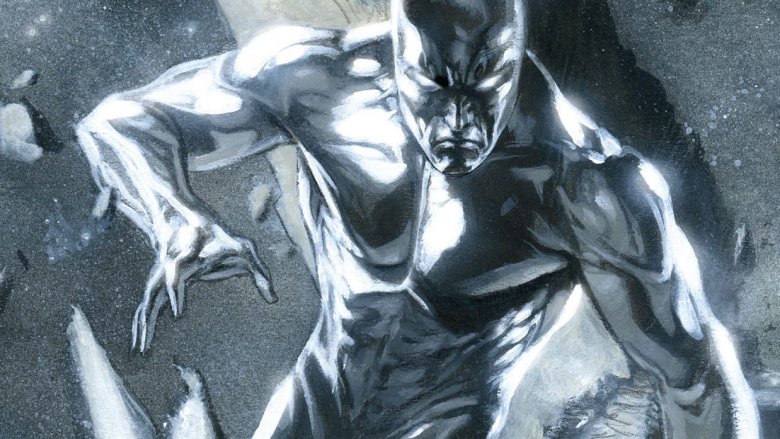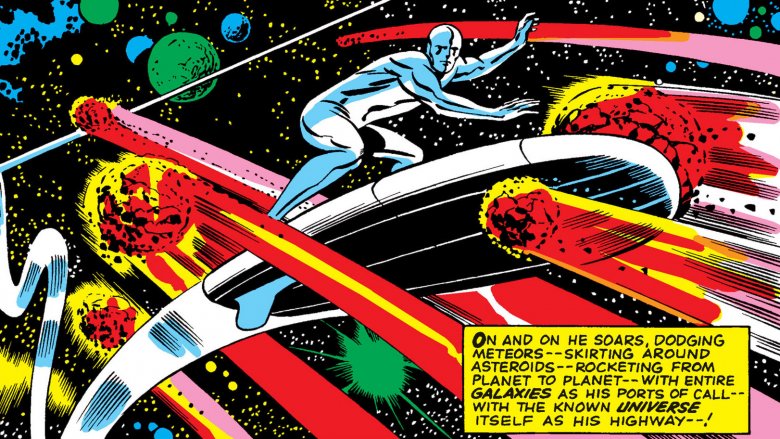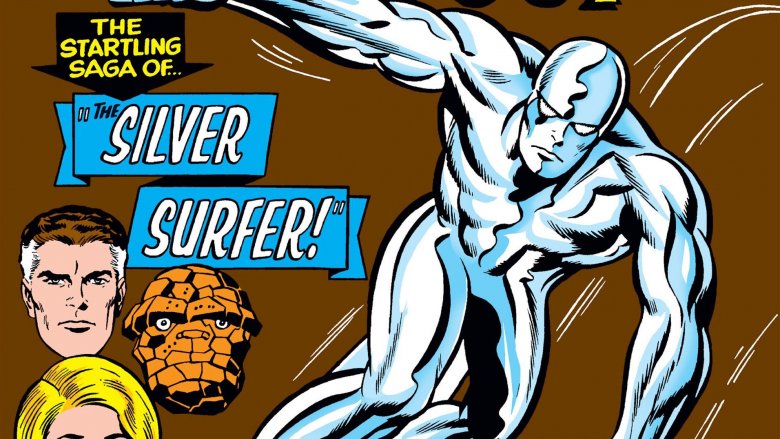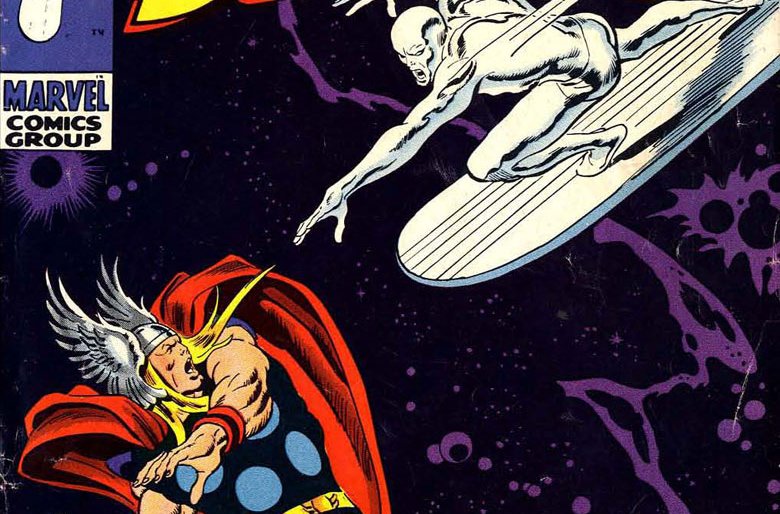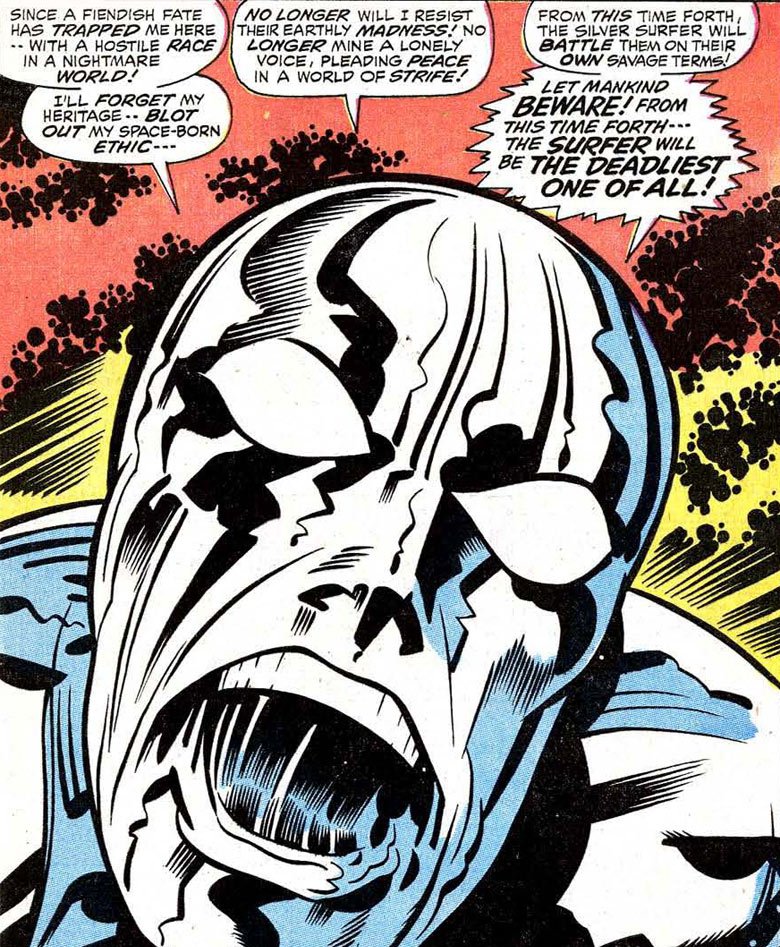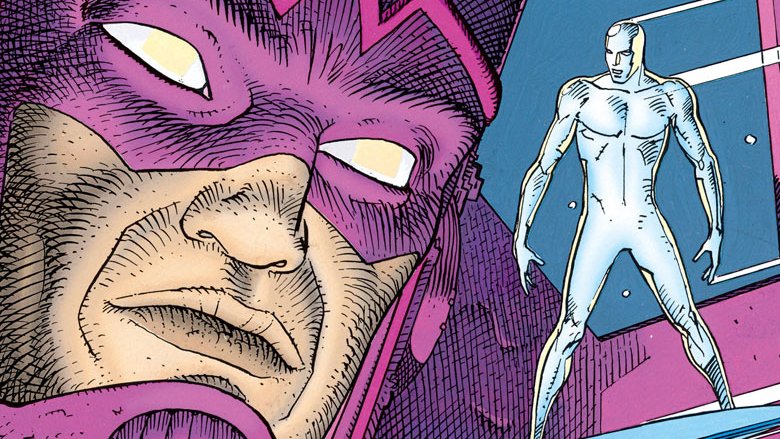The Untold Truth Of Silver Surfer
Of all the cosmic heroes roaming around the spaceways of the Marvel Universe, none have ever been as prominent as the Silver Surfer. Created in 1966 by Jack Kirby in the pages of Fantastic Four, he made his first appearance as the herald of the world-devouring Galactus, arguably the single strangest character in the Marvel Universe up to that point. As weird as he was, though, the success of that story quickly made him a favorite — not just for the readers, but for Stan Lee himself. Over the next 50 years, he became a cosmic pacifist, an exile on Earth, a harbinger of planetary doom, and even a secret weapon in the heroes' original battle against the Infinity Gauntlet.
Those big events, however, just scratch the surface of the Surfer's fascinating history. From his unlikely origins to his his surprising prominence in cartoons and even video games, here's the real truth behind Norrin Radd, the Silver Surfer.
Let's go surfin' now!
He's been a prominent character for so long that most readers don't even think about it anymore, but one of the more interesting things about the Silver Surfer is that he's probably the most successful example ever of a character created to capitalize on a fad.
After Stan Lee and Jack Kirby plotted a story about a cosmic threat showing up to devour the world, Kirby turned in pages that, much to Lee's surprise, featured what appeared to be a chrome-plated spaceman flying around on a surfboard. Kirby explained that Galactus was such a big deal that he needed a herald to announce his presence, but while that was a good reason for the spaceman, it didn't really explain the surfboard. For that, you had to look outside of comics.
Kirby's entire career in comics was marked by an awareness of trends and a knack for appealing to youth culture, from his creation of the romance comic genre with Joe Simon in the '50s to the super-powered hippies he'd create for DC in Forever People. With that in mind, the Surfer was undoubtedly an attempt to appeal to the kids of the '60s. This was, after all, the era where surfing was the hot new thing, with the Beach Boys racking up hits with "Surfin' USA" and "Surfin' Safari," and movies like Beach Party and Beach Blanket Bingo hitting theaters on an annual basis for the first half of the decade. Three years later, there would even be a surfing-themed episode of Batman about the Joker trying to take over Gotham by becoming "king of the surf, and all the surfers." With that much in the zeitgeist, it's no wonder that Kirby would decide on a cosmic surfboard (and a shiny little pair of trunks) for the new character he was springing on Lee.
The Coming of Galactus
While Lee might've initially been wary of dropping what he called "a nut on some kind of flying surfboard" into the middle of the Marvel Universe's most high-stakes story to date, the Surfer's original appearance in Fantastic Four #48 is what really makes the story work. In a time when most of Marvel's competitors were still filling issues with two or three complete stories — with an occasional "three-part novel" that would still be complete in a single issue — "The Coming of Galactus" kicks off a multi-issue epic. The entire issue builds to the arrival of Galactus on the last page, setting him up as not only a huge reveal, but as something so important that readers have to wait a month to see what he actually does. The rest of the issue is devoted to the other two characters introduced that month: the Watcher and the Silver Surfer.
Right off the bat, the Watcher is shown to be a being of incredible power, able to use a device called the Matter Mobilizer to set the skies of Earth on fire, or fill them with stones. The reveal is that those aren't threats to humanity; he's doing all of this in an attempt to hide us from the Surfer. As for the Surfer himself, we see the FF's previous cosmic villains, the shape-shifting Skrulls, hiding in terror as the Surfer passes them over, showing him as a threat well beyond what the FF had dealt with before.
Setting all that up here not only makes that issue better by making Galactus's arrival feel like a big deal, it also makes the Surfer turning on Galactus feel like a big deal. There's no way for Marvel's flagship characters to deal with this guy on their own, but with help from these two cosmic forces, they finally pull it off.
The fans read a little too much into it
Given the Surfer's prominence in the biggest Marvel story of the era, it's no surprise that the fans had an immediate reaction to his addition to the Marvel Universe, nor is it surprising that he was more than a little divisive. As the letters rolled in to the Marvel offices in 1966, readers like Doug Nikkel commented that "Silver Surfer is a corny name" (which, to be fair, it is), while David Carmichael wrote in with an angry screed asking "Why? Why don't you give the Fantastic Four a person, a single person, to fight, and not a bunch of space bums running around cluttering up the yarn and making the pages look utterly disgraceful?" Ouch.
Others were a little more kind — including future Batman editor Dennis O'Neil, a frequent fixture of the FF's letters page — but perhaps the strangest commentary came from a Houston, Texas reader named Greg Jones. As he wrote, "Galactus represented the Viet Cong, the powerful aggressor, but not realizing fully his error. The noble FF assumed the role of South Viet Nam — they needed help from a more powerful source. The Silver Surfer, as America, helped a lesser people in their time of need, even though he himself was not involved. And Alicia [Masters, the Thing's love interest] characterized Stan, Marvel, the President, and all other loyal, patriotic Americans."
Needless to say, that's a pretty wild interpretation of the a story about a space giant with a big hat trying to eat the planet. Even Stan Lee, responding to the letter in the pages of FF #52, seemed surprised by this one, writing "we can't dot an i without someone reading some deep subliminal message into it. (Of course, we do put a lot of personality into our i-dotting!)"
The Surfer goes solo
If Stan Lee was surprised and hesitant about the Silver Surfer's first appearance, that attitude was pretty short-lived. By the end of that first three-issue arc, Lee had clearly taken a liking to the character, likely because of what the Surfer allowed him to explore. Before he was caught up in reinventing the superhero genre, Lee's aspirations leaned towards writing science fiction novels.
With Galactus exiling the Surfer to earth at the end of his original story, Stan, joined by artist John Buscema, was free to tell stories that blended superheroic action with more philosophical sci-fi. They gave him an origin story, revealing that he was Norrin Radd, a resident of the planet Zenn-La who gave up his humanity to become Galactus's herald in order to convince Galactus to spare his home — and his love, Shalla-Bal. Beyond that, he spent his time fruitlessly hurling himself against a barrier that Galactus had set around the Earth, cursed to sadly witness the worst villainy our planet had to offer.
It represents some of Stan's best work of the era, with soaring masterpieces that are a little more thoughtful than the other action-packed tales he was scripting at the time. There were, however, a few problems, and the biggest one was that it just didn't sell. Despite the Surfer being a fan favorite character and Stan's personal investment in his success, that original series ended after only 18 issues.
Jack Kirby and the Savage Surfer
If you were paying attention a moment ago, you may have caught that it was John Buscema who provided the art for the Surfer's solo series, and not the character's creator, Jack Kirby. In one respect, that makes sense — while he was capable of creating comics at an impressively rapid speed, Kirby was busy drawing Fantastic Four, the company's flagship title. In another respect, though, Kirby saw it as one of his creations being taken away from him, adding to the enmity that had been building with Lee.
Kirby even had a different origin story in mind for the character. Rather than the tragic sacrifice of the peace-loving Norrin Radd, Kirby envisioned him as cosmic power personified, and wanted to take him in a direction that was significantly less philosophical. As a concession to Kirby, Lee brought him into the Silver Surfer series at #18 for a story where the Surfer would finally give in to the rage that had been building within him for four years, bringing him closer to Kirby's original plan. Sadly, that wasn't enough. While it promised that the next issue would launch "the savagely sensational NEW Silver Surfer," that next issue never came.
That same year, Kirby would leave Marvel for DC and the promise of more creative control. He would sum up his reasons for leaving Marvel, as revealed in a Comics Journal interview with his longtime assistant Mark Evanier, with the simple statement "I'm not going to give them another Silver Surfer."
Norrin Radd and Olivia Newton-John
Despite his ill-fated start as a solo character, the Silver Surfer remained one of Stan Lee's favorite characters. The belief that Marvel had something special and unique with the Surfer even led him to pitch a Silver Surfer movie.
Sean Howe's Marvel Comics: The Untold Story explains how it went down. In 1979, after Superman was a massive success, Hollywood suddenly had an interest in the same kind of superhero stories they'd been avoiding since Batman went off the air ten years earlier. To help Marvel capitalize on the foothold they'd gotten with the Incredible Hulk TV show, Stan spent a year in Los Angeles shopping around various projects, including a treatment he wrote for a Silver Surfer film. It actually got picked up, too, set up with a respectable $25,000,000 budget and Olivia Newton-John, who was riding high as a hot new star after her leading role in 1978's Grease, attached to star.
Obviously, that movie never happened, which is a real shame. While it's likely that Newton-John would've taken a role along the lines of Shalla-Bal or Alicia Masters, the fact that she was the only person connected to the movie inevitably leads us to wonder what it would've been like if she'd actually starred as the Silver Surfer. Suffice to say that Marvel in the '80s probably would've looked very different.
Parable
The late '80s were much kinder to the Surfer than his original attempts at a solo story had been. While Lee had asked other Marvel writers to avoid using the Surfer so he could maintain some control over his favorite character, 1987 saw him finally relenting. That year brought a new Silver Surfer series from Steve Englehart and Marshall Rogers, a team that had revitalized characters like Deadshot and Hugo Strange with their legendary run on Batman. It would wind up running for 148 issues. The following year, though, showed that Stan wasn't done with the Surfer just yet.
In 1988, Marvel put out Parable, a two-issue story with a script from Stan and art by the legendary French cartoonist Moebius. For most readers, this was the book that introduced Moebius to an American superhero audience, and it's easy to see why he was instantly recognized as a master of the form. His detailed, sweeping art was perfect for the story, which saw Galactus descending to Earth and declaring himself God so that he could feed off the worship of humanity. The Silver Surfer rises up from literally living on the street to free humanity from being controlled, dealing with an evangelist who worships Galactus and confronting the godlike Devourer of Worlds himself. In the end, Earth turns to the Surfer as their savior, and won't accept that he doesn't want their worship.
With beautiful art from Moebius and Lee at his operatic, philosophical sci-fi best, it's one of the best Surfer stories of all time. If, however, you're in for a little less religion and a little more action, 1990 saw the release of a massive Marvel Graphic novel, scripted by lee with painted art by Keith Pollard, called The Enslavers. Along with the ongoing series, these were the books that re-cemented the Surfer as a big deal at Marvel.
The Power Cosmic hits the NES
The Silver Surfer's return to prominence didn't stop on the comics page. In 1990, The Surfer made his video game debut on the Nintendo Entertainment System — and to give you an idea of where he ranked, the only other Marvel games on the NES at the time starred the X-Men and the Punisher, two of the most popular franchises of the '90s. Silver Surfer, with its Gradius-style space-shooter action, managed to beat even Spider-Man to his NES debut by two full years.
Unfortunately, being early doesn't always mean being great. While it boasted some pretty incredible graphics and a killer soundtrack that ranks among the best of the NES era, Silver Surfer is mostly remembered for a staggering difficulty level that kept almost everyone who played it from actually beating the game.
If they had, though, they would've been treated to a pretty bizarre plot. Dispatched on a mission of cosmic importance by Galactus, the Silver Surfer faces foes like Mephisto and Firelord, another former herald. The final boss, though, is a surprise. Mr. Sinister, an X-Men foe with no real connection to the cosmic side of the Marvel Universe, is depicted as the last villain of the game, but the actual character you fight is a 15 foot-tall purple hulk with a handgun and a pair of white go-go boots. Maybe it's for the best that nobody ever got to see him.
Silver Surfer: animated!
In 1998, Norrin Radd surfed his way out of the comics page again, and onto the small screen. Following up on the success they'd had with X-Men and Spider-Man, Fox Kids picked up a Silver Surfer animated series. It only lasted for a single season — canceled due to an apparent legal conflict between Fox and Saban, the production company behind X-Men, Power Rangers, and other hits for the network — but it was actually a success in the ratings.
The show had a lot going for it, including an art style heavily influenced by Jack Kirby, but looking back, it's mostly notable for two things. First, it featured the animated debut of Thanos, who would go on to be the biggest bad guy of the Marvel Cinematic Universe, as one of the show's primary antagonists. Second, and perhaps far more memorable, it spawned a pretty interesting line of action figures. Not only did it feature toy versions of the Surfer, Galactus, and the first Thanos action figure ever, the show's focus on the cosmic side of the Marvel Universe also led the line to bring in more obscure characters like Adam Warlock and Beta Ray Bill.
The cinematic rise (and fall) of the Silver Surfer
If you ever need an indication of how popular the Surfer was as a character, and how much Marvel wanted him to succeed, consider this: when it came time to title the second Fantastic Four movie, in which the FF would be dealing with the cosmic threat of Galactus, the Devourer of Worlds was left completely out of the title. Instead, Fantastic Four 2 bore the title Rise of the Silver Surfer, hinting at plans to spin the skyrider of the spaceways off into his own big screen adventure.
Unfortunately, Rise's failure at the box office put an end not only to those plans, but of that version of the Fantastic Four continuing at all. Instead of a planned third movie that, according to screenwriter Don Payne, would've potentially involved the Skrulls and the Inhumans showing up, the FF was rebooted in 2015 with another movie that landed with an even more resounding thud than its predecessors, managing to perform even worse at the box office.
But with 35 years of Marvel trying to bring the Surfer to the big screen, it's easy to look at Rise of the Silver Surfer as a mere setback rather than the final nail in the coffin. With Disney's pending merger with Fox, the success of cosmic-focused films like Guardians of the Galaxy, and the Surfer's prominence in stories like the original Infinity Guantlet, it's far from out of the question that we might just see Norrin Radd and his infamous board surfing their way into the MCU one day.
